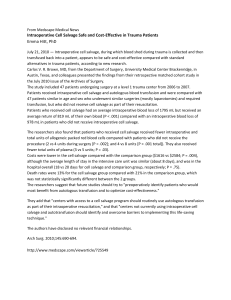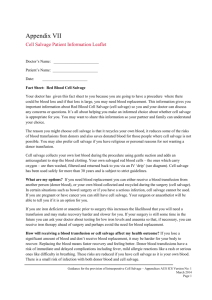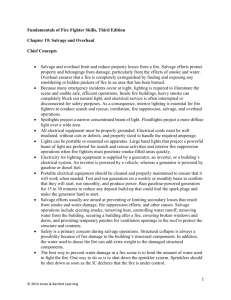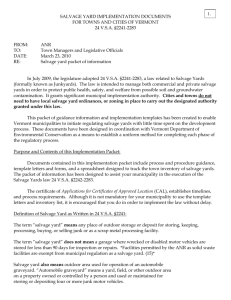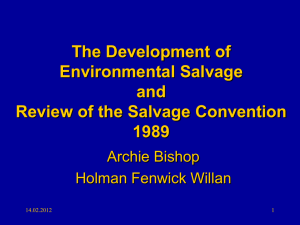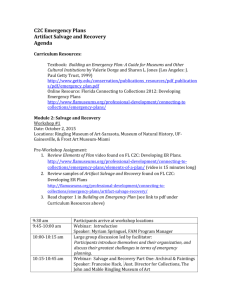Emergency Plans for Heritage Buildings & Collections
advertisement
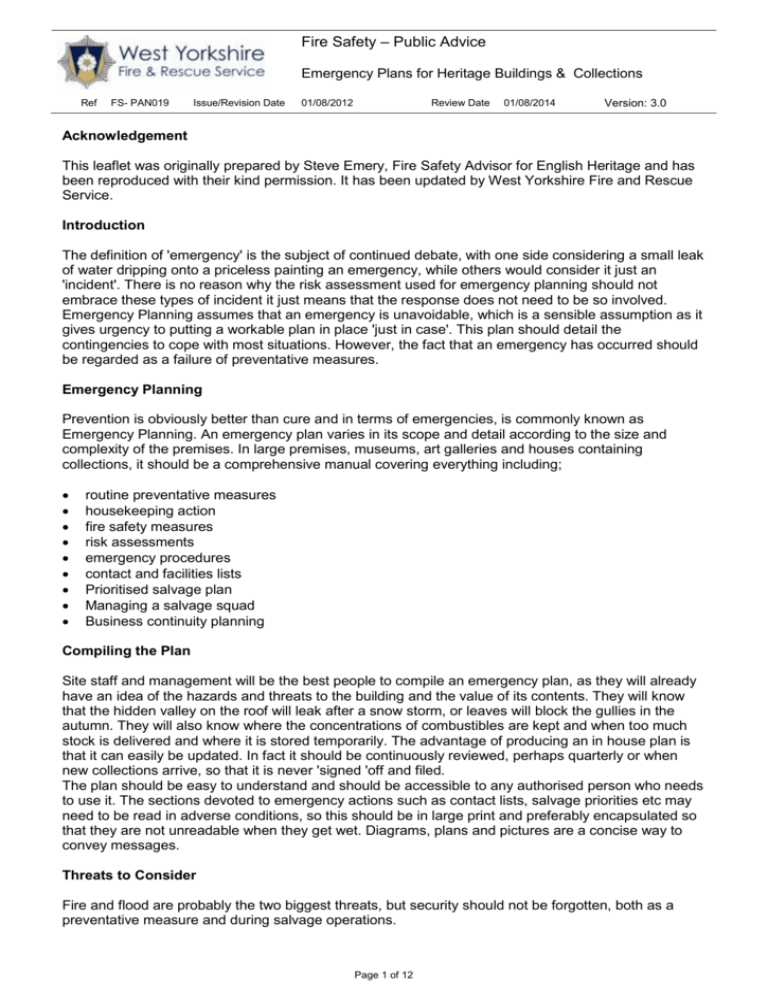
Fire Safety – Public Advice Emergency Plans for Heritage Buildings & Collections Ref FS- PAN019 Issue/Revision Date 01/08/2012 Review Date 01/08/2014 Version: 3.0 Acknowledgement This leaflet was originally prepared by Steve Emery, Fire Safety Advisor for English Heritage and has been reproduced with their kind permission. It has been updated by West Yorkshire Fire and Rescue Service. Introduction The definition of 'emergency' is the subject of continued debate, with one side considering a small leak of water dripping onto a priceless painting an emergency, while others would consider it just an 'incident'. There is no reason why the risk assessment used for emergency planning should not embrace these types of incident it just means that the response does not need to be so involved. Emergency Planning assumes that an emergency is unavoidable, which is a sensible assumption as it gives urgency to putting a workable plan in place 'just in case'. This plan should detail the contingencies to cope with most situations. However, the fact that an emergency has occurred should be regarded as a failure of preventative measures. Emergency Planning Prevention is obviously better than cure and in terms of emergencies, is commonly known as Emergency Planning. An emergency plan varies in its scope and detail according to the size and complexity of the premises. In large premises, museums, art galleries and houses containing collections, it should be a comprehensive manual covering everything including; routine preventative measures housekeeping action fire safety measures risk assessments emergency procedures contact and facilities lists Prioritised salvage plan Managing a salvage squad Business continuity planning Compiling the Plan Site staff and management will be the best people to compile an emergency plan, as they will already have an idea of the hazards and threats to the building and the value of its contents. They will know that the hidden valley on the roof will leak after a snow storm, or leaves will block the gullies in the autumn. They will also know where the concentrations of combustibles are kept and when too much stock is delivered and where it is stored temporarily. The advantage of producing an in house plan is that it can easily be updated. In fact it should be continuously reviewed, perhaps quarterly or when new collections arrive, so that it is never 'signed 'off and filed. The plan should be easy to understand and should be accessible to any authorised person who needs to use it. The sections devoted to emergency actions such as contact lists, salvage priorities etc may need to be read in adverse conditions, so this should be in large print and preferably encapsulated so that they are not unreadable when they get wet. Diagrams, plans and pictures are a concise way to convey messages. Threats to Consider Fire and flood are probably the two biggest threats, but security should not be forgotten, both as a preventative measure and during salvage operations. Page 1 of 12 Fire Risks Museums and art galleries may not appear to be high fire risk premises, with a very low fire loading, few ignition sources, high ceilings and large open spaces with a high level of supervision. Many of these public buildings are Georgian or Victorian and have grand public spaces, but often hidden away in the basements and upper floors are smaller rooms used for a variety of purposes, including offices, workshops, archives, kitchens, boiler rooms and storage areas. It is in these areas that the real dangers lie; The highest concentrations of combustibles are kept here More ignition sources are found in these areas than the public rooms The ceilings are lower which will hasten the spread of fire Housekeeping should not be less vigorous in these areas because they are out of the public eye Valuable collections are often stored here when not on public view These areas are more likely to have had holes made in fire resisting walls, for the passage of services Dangers of Using Multi-Point Sockets Archive with High Fire Loading & Low Ceiling Roof spaces are often used for the storage of combustibles and together with the roof timbers provide fuel for a serious fire, which would be almost impossible to tackle successfully. Fire fighting water is prevented from being applied from the outside because the roof is designed to keep water out and internal access is usually restricted. Even if access is made, the conditions inside the roof space could be extremely hazardous because of the lack of ventilation. Many of the large fires witnessed in historic buildings have only involved the lower floors after the roofs have collapsed. Hidden voids can lead to unseen fire spread to areas remote from the origin of the fire and a fire in these spaces is extremely difficult to fight. The upper floors are more difficult to access to fight fires and hose may need to be laid up stairs and along corridors. This will lead to delays before a fire can be tackled. The basement is often very difficult for fire fighters to access because they may need to fight their way through the heat layer to tackle a fire and subsequent ventilation is not always easy. Page 2 of 12 Under Floor Void Basement High Fire Load & Access Problems Other Fire Hazards Whenever there are contractors on site, for whatever reason, from catering for an event to displaying a new collection or where building works are taking place there will be additional hazards. A new risk assessment should be undertaken to address each situation. Catering Where caterers are used for events the contract should be clear about what operations can and cannot be carried out, what areas can be used and who has the authority (preferably site staff) to make sure that the conditions of contract are being adhered to. Menus should be agreed to in advance so that additional hazards such as deep fat frying or the use of blowtorches can be anticipated. Additional safeguards can then be put into place, or if necessary the menu can be changed to eliminate the hazard. By making these conditions clear in advance, problems arising in the middle of an event can be avoided. Building Works The additional threats which building works pose can include; Loss of fire separation caused by the removal of doors or repair of partitions or ceilings. Temporary isolation of fire detectors to avoid false alarms caused by dust. Additional fire loading caused by the temporary storage of building materials and packaging. Additional sources of ignition caused by temporary lighting, plumbing works, sparks from cutting gear, burning paint and lead burning. These ignition sources should be controlled by a system of Hot Work Permits, or better still banning hot work altogether. Poor water supplies because hydrants have been covered or have not yet been fitted. Poor fire service access because of temporary hoarding or site huts. Will the Building Survive a Fire? One way of determining the likely effect of fire on a building and its contents is to use the 'Building Fire Performance Evaluation Methodology', otherwise known as the 'Method'. This involves looking for the room that seems to be the highest fire risk. Fire in the room of origin It is then assumed that a fire occurs which has enough energy to spread and involve the whole room (flashover). Whether this occurs or whether it just burns out will depend on the amount of combustibles, how close they are to each other, the available ventilation, the volume of the room and Page 3 of 12 the ceiling height. These factors and the flammability of the contents of the room will also give an indication of how quickly it will reach full room involvement. Subsequent fire spread A judgement is then made as to the probability that the fire will spread to an adjacent space and then the probability that it will involve the whole floor and then the whole building. This can be judged by looking at the fire resistance of the partitions ceilings and doors. The time taken for fire to spread from the room of origin will also depend on the fire rating of these various elements of structure. Time taken until the fire is fought The time taken before an intervention, such as first aid fire fighting, or tackling by the fire service is then assessed by looking at the following factors; How quickly will the fire be detected? Is automatic detection provided and is it heat or smoke activated? How long will it take before first aid fire fighting commences? Is there a 24-hour presence so that first aid fire fighting can be instigated? If there is not a 24-hour presence is the fire alarm monitored so the fire service can be called automatically? How long will it take for the fire service to attend? This will vary according to the time of day, how close the nearest fire appliance is, the distance from the fire station, the traffic conditions and the ease of access. When the fire service arrives, how long will it take before water can be applied to the fire? This will depend on how close the fire engines can get to the building, the available water supplies, the distance that hoses will need to be laid between the water supplies and the fire engine and between the fire engine and the fire. If the total time taken from a fire starting to the point that fire fighting begins is longer than the time taken for the fire to spread beyond the room of origin, then some remedial action needs to be taken. Page 4 of 12 Remedial action and listed buildings There will probably be a whole range of possible actions to take to improve the building fire performance. Not all of them may be possible because of listed building constraints, cost or desirability. The following questions may help decide on which course of action to take; What factors have been identified as the biggest threats to the building and contents? Can these threats be reduced to an acceptable level that does not involve any upgrading, such as reducing the fire load, or changing the use of the building or parts of the building. If improvements are necessary, are they reversible, sympathetic to the appearance of the building and avoid damage to the historic fabric? Will the improvements be effective? For instance, the provision of a fire alarm and detection system, which is not monitored, will not provide any protection when the building is unoccupied. The provision of an automatic detection system may cut down the time before a fire is discovered, but is it reduced sufficiently so that it is unlikely that fire will spread to adjoining spaces. If not, another layer of improvements, such as a sprinkler system or local water mist system may be necessary. Will the improvements be affordable and if not is there a more cost-effective alternative? Heat & Smoke Damage - Top of Room Salvaged Items on Lawns . Sympathetic Exit Sign Page 5 of 12 Flooding Emergency Sources of flooding All possible sources of flooding should be considered, including burst pipes, tidal surges, riverbanks bursting, and runoff from hillsides during rainstorms or melting snow. After discounting the events that are impossible, the volume of water that could be expected from any of the remaining sources should be estimated. As with the 'Building fire performance evaluation methodology', the time from the start of the flooding to discovery together with the volume and the likely course that the water takes will determine the damage caused. Local flooding The position of stopcocks should of course be noted on the emergency plan. However the route of water pipes, position of tanks, cisterns, ball cocks, valves, hose reels and overflow pipes can give an indication of where local flooding could occur. If a Rembrant is sited below a bathroom, for example, but is in the best place, for presentation reasons it might be wise to decommission the bathroom. When work is being carried out on water or heating systems there is a higher risk of leaks occurring, so it would be prudent to carry out post work checks before locking up the premises for the evening. The Ball Cock Natural Flooding Where there is the possibility of flooding from natural causes such as water run-off or rivers rising, it would be worthwhile looking at the reasons that it is not occurring regularly. This may be because of efficient road drainage or the edge of the basement area has a raised course of bricks around it. Now we need to look at what would happen if the drain becomes blocked or the river rises an extra 2 metres. If these eventualities result in the flooding of the basement, would it constitute a disaster? It may be that simply moving the picture store to a higher floor may alleviate the problem Page 6 of 12 Fire Fighting Run-Off Water Fire services try to cause as little water damage as possible when fighting fires, but at serious high level incidents the water from their hoses will pour into the rooms below. A large fire may typically require the use of 6 jets, each discharging over 500 litres per minute. The hydraulic platform may well discharge 1800 litres a minute. This is a total of 4.8 tonnes of contaminated water a minute. The weight of water may well cause further structural damage and will certainly cause debris to cascade onto lower floors. It may be possible to cover objects to minimise water damage, but the best course of action would be to divert as much as possible to the outside, using waterproof sheets and hoppers if available. Debris Collapsing onto Lower Floors Cover Objects to Prevent Water Damage Removal of objects before the water reaches them is another option, but relies on there being enough people and time to remove them safely. Collections of books are a particular problem because of the number and weight of them. If the collection is on upper floors a book chute may be required to get them to ground level quickly. Salvage Plan An emergency plan should be drawn up and the plan should identify; The personnel responsible for salvage operations, including the Salvage officer and their deputy Site and building plans Salvage priorities Salvage procedures Emergency first aid conservation Further treatment procedures Training of the Salvage Teams Salvage teams may need to enter a building which has suffered fire or other damage. They will only be allowed in those areas which the officer in charge of the fire service gives permission for. This may be when; Fire is at high level, entry into rooms below may be possible. When fire is in adjacent rooms and ‘fire is surrounded’ When fire is remote from collection rooms After fire has been extinguished Page 7 of 12 Personal Protective Equipment To allow access the salvage teams should have Personal Protective Equipment, which includes Identification, Hard Hats, Fluorescent jackets, Steel toed boots/shoes, Torches. The training should include how to undertake a risk assessment and working safely in adverse conditions. The most likely risks in order are; Manual Handling Trips and Slips Objects Falling (Tiles, Overhead working) Burns and Scalds Electric Shock Smoke Inhalation Structural Collapse Drowning More practical aspects of training should include reading plans, identifying objects on the salvage list, removing paintings from their fixings, object handling and first aid treatment of damaged objects. All these should be practiced in simulated conditions. These practices could periodically include joint exercises with the fire service. A log book should be provided so that a record of training can be kept. One method of moving large numbers of objects is to form a human chain. This involves a line of people who pass objects from one to the other. To be effective the distance between each person in the chain should be such that the objects can be passed down the line without anyone needing to move. The disadvantage of a chain is the number of times the objects are handled, but this should be weighed up against the speed of operations. There should be a Check in/out procedure so that everyone can be accounted for if an evacuation takes place. Everyone should be aware of the evacuation procedure. Page 8 of 12 Salvage Priorities (Snatch Lists) These salvage lists are best in the form of photographs of the items to be rescued, their position in the room and building and any special measures needed to remove them. This may be the manual handling requirements, removal techniques, or equipment required. Value of the exhibits should not be included for security reasons. A description of the object is sometimes more useful than the title. (See appendix A) Salvage Procedures If a room is completely filled with items of similar value, it is still worth sorting them into an order of removal. This could perhaps be by order of rarity, historic significance, ownership, or simply ease of removal rather than simply giving them all a priority 1 rating. The procedures for salvage will vary according to the scale of the incident, but it makes sense to plan for the worst case scenario and for removal of all the objects. Points to consider are; Contacts Specialist facilities Floor plans Key to floor plans Salvage information Procedures for removal of items Equipment Response equipment Composition of salvage teams Safe areas to store objects Arrangements for the longer term storage or treatment of objects Salvage store, fixed or mobile Maintenance of salvage equipment Security The probability of arson attacks can be reduced with good security measures, but the difficulties of removing secure objects during salvage operations need consideration. In addition the movement and storage of valuables after removal requires a degree of pre-planning. The security of the salvage priority list and the information it contains should also be considered because it also needs to be accessible in emergencies. Testing and Monitoring Once a plan is written, it must remain fit for purpose, so it needs to be tested, maintained and those likely to use the plan need to be familiar with it and should be adequately trained. Write the Plan – Be Flexible Undertake a Paper Exercise Update the Plan Full Scale exercise Update Plan Contacts One of the most difficult items in the plan to keep up to date is the contact lists, both for management teams, members of salvage teams and equipment suppliers. Try contacting people on the lists at different times of the day, in the evenings, at weekends and other unusual times to see if the existing method of making contact is still efficient. When a disaster occurs the contacting of staff may take a long time and occupy the person who is first on the scene and has many tasks to perform. An alternative solution is to contract the task out to a third party, such as a call receiving centre. Part of the contract would involve the third party periodically checking the lists and making test calls. Page 9 of 12 Incident Reporting Learning from experience is a very useful tool. All incidents even if they are relatively minor should be reported to management, so that a record can be made of their nature, size and potential threat. These reports can then be used to take action before the incident is repeated, which could be more serious the second time around. First Aid Treatment of Objects The first few hours after a disaster are critical to the long term survival of fragile historic artefacts. If the condition of the objects can be stabilised as soon as possible the long term damage by mildew or rot can be avoided. The salvage plan should include the provision of first aid equipment and a suitable place, either permanent or temporary for treatment. The above picture shows temporary shelters and tables for the preparation of fire damaged books. These are being prepared for shipment to a specialist deep freeze and restoration facility. Conclusion It is important to understand and assess the risks to the property, so you can take action to minimise them. Prevention is better than cure and writing the plan is the right time to ensure that all preventative measures have been completed; the plan is produced to an acceptable level; it is maintained, tested and reviewed. Ensure users are adequately trained and the fire and rescue service are made aware of its content. Useful information and links West Yorkshire Fire Authority have been informed there are approximately 1500 heritage sites throughout the county and in considering its responsibility for enforcing the current fire protection legislation for the protection for all relevant persons a group has been established within the authority to look at how the current legislation The Regulatory Reform (Fire Safety) Order 2005, is being applied to Heritage sites throughout the county. This regime of fire safety enforcement came into force on 1st October 2006 and affects employers and those who are responsible for non-domestic, industrial, commercial and residential premises. Selfemployed people and the voluntary sector are also brought within this regime. Page 10 of 12 The Order simplified, rationalized and consolidated fire safety legislation and it provides for a riskbased approach to fire safety allowing more efficient and effective enforcement by the fire and rescue service. See the website for the Department of Communities and Local Government for further details. At the core of the legislation lies the Fire Risk Assessment which has to be carried out as part of complying with the fire safety order. This is an organized appraisal of your work activities and the workplace to enable you to identify potential fire hazards, and to decide who (including employees and visitors) might be in danger in the event of fire, and their location. You will then evaluate the risks arising from the hazards and decide whether the existing fire precautions are adequate, or whether more needs to be done. In general fire risk assessments in the case of a normal building is carried out by checking the compliance of the building to relevant fire safety guides, making assessing the risks a straight forward task. English Heritage can be contacted to obtain an emergency plan template at iep@englishheritage.org.uk Page 11 of 12 Appendix A Example of a salvage card to provide in case of emergency (English Heritage) Page 12 of 12

